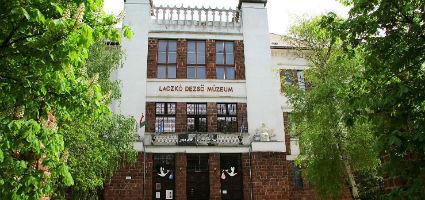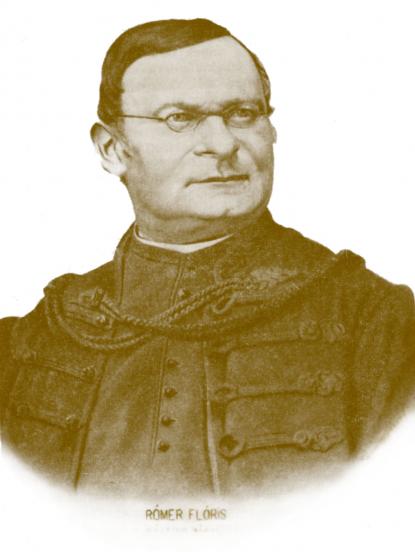2024. May 5. Sunday
Dezső Laczkó Museum - Veszprém
 |
Address: 8200, Veszprém Török Ignác u. 7.
Phone number: (88) 789-791
E-mail: titkar@ldm.hu
Opening hours: Thu-Sat 10-18
|
The exhibition has closed for visitors.
2015.06.10. - 2015.07.26.
Flóris Ferenc Rómer was a Benedictine monk, a true polymath: sometimes referred to as "the father of Hungarian archaeology". However, he played a key role in foundation of art history writing and preservation of historic buildings, also laying the foundations of the institutional system. His involvement in ethnography, science and work of art even today is hardly ever mentioned.

Ferenc Rómer was born in Pozsony on 12 April, 1815, into a German speaking family. After finishing elementary school, he continued his studies in Pannonhalma, then in Győr where he later on graduated from the Academy. He was ordained a priest in 1838, then he worked as a Latin and Hungarian language teacher and also taught natural history in Győr. In his spare time he hiked a lot, toured the Bakony, drew pictures and painted. He began teaching at the Academy in Pozsony in 1845, then two years later he was hired as a tutor for the Archduke Joseph. He followed the events of the revolution, enlisted as a voluntarily in September 1848; during the War of Independence as a sapper he reached the rank of captain. In 1849, he was sentenced to eight years in prison in a fortress, but was released after five years of confinement, on amnesty.
In 1857 he returned to teach at the Benedictine Grammar School in Győr. In 1859, he managed to have the old school store reconstruct as a museum. He and the archivist Károly Ráth began and later on edit the Győr History and Archaeology Booklets, the first national historical science journal.
He moved to Pest in 1861, started working as the guardian for the Hungarian Academy of Sciences the Manuscript and Medal Storage,. Subsequently, he was the headmaster of the Pest Catholic High School, after which he was a professor and also worked as secretary for the Archaeological Committee of the Academy. He edited the Archaeology Bulletin, the Archaeology Report, which has been the prestigious journal for the archaeological profession ever since. In 1869 he became the guardian for the Museum of National Antiquities Collection and became member of the Academy in 1871.
He considered "experiential teaching" important in education which is still considered modern today. His work had an immense impact on the history of rural science and science of archaeology of his time. The multidisciplinary Book of Bakony is a fine example of scientific education.
He moved to Nagyvárad in 1878 and spent the rest f his life with researches and scientific work. He died in Nagyvárad on 18 March, 1889 and was buried there as well.
The Rómer Flóris Art and History Museum presents the travelling exhibition co-organized by several other museums. The travelling exhibition is to visit several towns in Hungary and abroad to present the scientific work of Flóris Rómer.

Ferenc Rómer was born in Pozsony on 12 April, 1815, into a German speaking family. After finishing elementary school, he continued his studies in Pannonhalma, then in Győr where he later on graduated from the Academy. He was ordained a priest in 1838, then he worked as a Latin and Hungarian language teacher and also taught natural history in Győr. In his spare time he hiked a lot, toured the Bakony, drew pictures and painted. He began teaching at the Academy in Pozsony in 1845, then two years later he was hired as a tutor for the Archduke Joseph. He followed the events of the revolution, enlisted as a voluntarily in September 1848; during the War of Independence as a sapper he reached the rank of captain. In 1849, he was sentenced to eight years in prison in a fortress, but was released after five years of confinement, on amnesty.
In 1857 he returned to teach at the Benedictine Grammar School in Győr. In 1859, he managed to have the old school store reconstruct as a museum. He and the archivist Károly Ráth began and later on edit the Győr History and Archaeology Booklets, the first national historical science journal.
He moved to Pest in 1861, started working as the guardian for the Hungarian Academy of Sciences the Manuscript and Medal Storage,. Subsequently, he was the headmaster of the Pest Catholic High School, after which he was a professor and also worked as secretary for the Archaeological Committee of the Academy. He edited the Archaeology Bulletin, the Archaeology Report, which has been the prestigious journal for the archaeological profession ever since. In 1869 he became the guardian for the Museum of National Antiquities Collection and became member of the Academy in 1871.
He considered "experiential teaching" important in education which is still considered modern today. His work had an immense impact on the history of rural science and science of archaeology of his time. The multidisciplinary Book of Bakony is a fine example of scientific education.
He moved to Nagyvárad in 1878 and spent the rest f his life with researches and scientific work. He died in Nagyvárad on 18 March, 1889 and was buried there as well.
The Rómer Flóris Art and History Museum presents the travelling exhibition co-organized by several other museums. The travelling exhibition is to visit several towns in Hungary and abroad to present the scientific work of Flóris Rómer.
